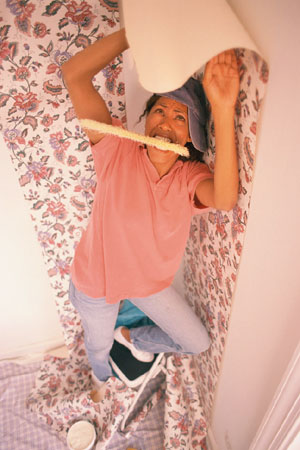|
Changing the Walls Around You
With a wide variety of patterns, wallpaper can provide a room with a new
look and feel. By carefully following a few steps you can paper a room
yourself, and achieve the look you want.
 Prepping for wallpaper is an important step if you want to your walls to
look good and for the papering job to last. Wash the walls to remove dirt
and dust and then apply a vinyl-acrylic sizing. This is applied just like
paint, and it will dry to be a bit tacky to the touch. This sizing material
provides adhesion when applying the paper, and will allow for easy removal
if you decide to remove the wallpaper in the future.
Prepping for wallpaper is an important step if you want to your walls to
look good and for the papering job to last. Wash the walls to remove dirt
and dust and then apply a vinyl-acrylic sizing. This is applied just like
paint, and it will dry to be a bit tacky to the touch. This sizing material
provides adhesion when applying the paper, and will allow for easy removal
if you decide to remove the wallpaper in the future.
If the wall is painted with a flat oil-based paint all you need to do is
clean and size the wall. If the paint is a shiny oil-based paint, treat the
wall with a de-glosser so the wallpaper will adhere better. Untreated walls
and latex painted walls should be treated with an oil-based primer before
sizing. If you cannot tell what is on the wall, you should prime the wall.
While it is possible to hang new wallpaper over old wallpaper, as long as
the new paper is lighter than the old paper, it is not advisable. You will
get a nicer look for the new wallpaper if you start with a clean, primed,
wall.
Since wallpapering is not a neat process, be sure to protect the floor and
any furniture in your room with plastic tarps. You will also need to wash
excess glue off your hands and the wallpaper itself frequently.
Once your walls are ready to go, select an unobtrusive section of your room
to begin-like in a corner or an edge with a window or a door. The first
strip you lay will set the precedent for the rest of the room, as any small
mistake in the first strip will only be emphasized with each new sheet that
is applied.
Use a chalk line (a tool used to draw straight lines on walls with chalk) to
be sure the first line you draw is perfectly straight. Then cut several
lengths of wallpaper a few inches taller than your wall.
Instructions will vary for the method to paste the paper to your wall. Be
sure to follow the manufacturer's instructions closely.
Once you apply the paper be sure it is even with the chalk line, or you will
need to remove the paper and start again. After the paper is set on the
wall, the top and bottom should be tight against corners and baseboard
molding. Trim the top and bottom of the paper with a sharp utility knife to
get a good cut, one that does not tear the paper. Clean the excess paste
off of the sponge and hang the other strips, waiting 10 to 15 minutes for
each strip to dry before starting the next. These strips should be about
1/8 inch from the first strip when you first apply them, then slide the new
strip towards the previous strip. Allow your new strip to buckle just a bit
to accommodate the shrinking that will occur when the strips dry. Finally,
using a seam roller will help to seal the seams of each strip.
Sources used in this article include www.doityourself.com and www.Easy2.com.
| 
